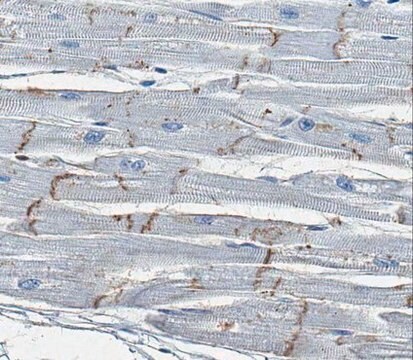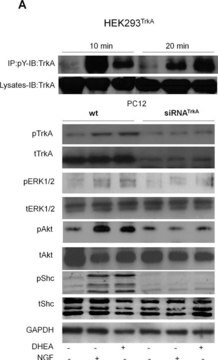AB1728
Anti-Connexin 43 Antibody
CHEMICON®, rabbit polyclonal
Sinónimos:
Gap Junction alpha-1 Protein (CxA-1)
About This Item
Productos recomendados
Nombre del producto
Anti-Connexin 43 Antibody, CT, cytosolic, Chemicon®, from rabbit
biological source
rabbit
Quality Level
antibody form
affinity isolated antibody
antibody product type
primary antibodies
clone
polyclonal
purified by
affinity chromatography
species reactivity
human, rat, mouse
packaging
antibody small pack of 25 μg
manufacturer/tradename
Chemicon®
technique(s)
ELISA: suitable
immunofluorescence: suitable
immunohistochemistry: suitable
immunoprecipitation (IP): suitable
western blot: suitable
NCBI accession no.
UniProt accession no.
shipped in
ambient
target post-translational modification
unmodified
Gene Information
human ... GJA1(2697)
General description
Specificity
Immunogen
Application
2-10 µg of a previous lot was used in immunoprecipitation.
ELISA:
A previous lot of this antibody was used at 1:10,000-100,000 dilution using 50 - 100 ng Cx43 control peptide (Catalog number AG636) per well.
Optimal working dilutions must be determined by end user.
Cell Structure
Adhesion (CAMs)
Quality
Western Blot Analysis: 1:500 dilution of this lot detected CONNEXIN 43 on 10 μg of Huvec lysates.
Target description
Physical form
Storage and Stability
Analysis Note
Positive Control: Heart tissue, mouse brain tissue lysate.
Other Notes
Legal Information
Disclaimer
¿No encuentra el producto adecuado?
Pruebe nuestro Herramienta de selección de productos.
Optional
Storage Class
10 - Combustible liquids
wgk_germany
WGK 2
flash_point_f
Not applicable
flash_point_c
Not applicable
Certificados de análisis (COA)
Busque Certificados de análisis (COA) introduciendo el número de lote del producto. Los números de lote se encuentran en la etiqueta del producto después de las palabras «Lot» o «Batch»
¿Ya tiene este producto?
Encuentre la documentación para los productos que ha comprado recientemente en la Biblioteca de documentos.
Nuestro equipo de científicos tiene experiencia en todas las áreas de investigación: Ciencias de la vida, Ciencia de los materiales, Síntesis química, Cromatografía, Analítica y muchas otras.
Póngase en contacto con el Servicio técnico




![Cucurbit[8]uril hydrate contains acid of crystalization](/deepweb/assets/sigmaaldrich/product/structures/281/346/2a1240af-8d5f-480f-a051-aa5f7a33f3ab/640/2a1240af-8d5f-480f-a051-aa5f7a33f3ab.png)


